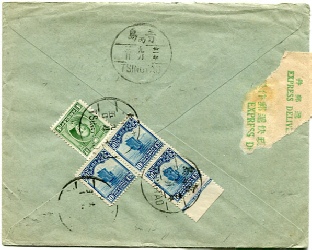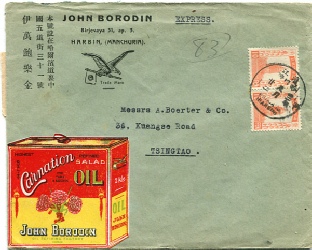
Cliquez sur les images pour agrandir -

LETTRE
23 août 1932 -
–
August 23th, 1932 -

|
Dimensions : |
155 x 126 mm |
|
|
Tarif (Mandchoukouo) : |
Lettre pour la Chine, par 20g :… 20g supplémentaires (1x4 fen). : Recommandation :…………….. Surtaxe par exprès :…………… Total :……………………………. |
4 fens 4 fens 6 fens 6 fens 20 fens |
|
Tarif (chinois) : |
Lettre intérieure, par 20g :……… 20g supplémentaires (1x6cents): Recommandation :……………… Surtaxe par exprès :…………….. Total :…………………………….. |
6 cents 6 cents 10 cents 12 cents 34 cents |
|
Période de valeur : |
Mandchoukouo, première date recensée. Chinoise, du 01/05/1932 au 19/05/1932 (1) |
|
|
Timbres utilisés : |
Mandchoukouo, YT n°11 en paire Chinois, YT n°190 (x3) et 223 |
|
|
Oblitération : |
N°22.1 Harbin 23/08/1932 |
|
|
Période d’utilisation : |
Première date recensée |
|
|
Indications : |
« EXPRESS » à la machine |
|
|
Arrivée : |
Tsingtao 3/09/1932 et 5/09/1932 |
|
|
Size : |
155 x 126 mm |
|
|
Rate (Manchukuo) : |
China letter, per 20g:…………… Added 20g (1x4fen):……………. Registration:……………………. Epress fee:……………………… Total:……………………………. |
4 fen 4 fen 6 fen 6 fen 20 fen |
|
Rate (China) : |
Domestic letter:………………… Added 20g (1x6cents):…………. Registration:…………………….. Express fee:…………………….. Total:…………………………….. |
6 cent 6 cent 10 cent 12 cent 34 cent |
|
Period of rate : |
Manchukuo, first date Chinese, 05/01/1932 to 09/19/1940 |
|
|
Stamps : |
Manchukuo, SG n°11 in pair China, ST n°277 (x3) and 391 |
|
|
Postmark : |
N°22.1 Harbin 08/23/1932 |
|
|
Period of use : |
First date |
|
|
Instruction : |
« EXPRESS » at the typewriter |
|
|
Arrival : |
Tsingtao 09/03/1932 and 09/05/1932 |
|
Comme je l’ai indiqué dans ma présentation, « en histoire postale, il y a toujours quelque chose à découvrir ». En voici un exemple : En effet, aucun des tarifs en ma possession ne faisaient état de surtaxe pour un envoi « Par Exprès », pour la Chine, avant le 10 janvier 1935 -
Ce courrier est donc exceptionnel par son tarif. En effet, l’existence d’un service « Exprès » vers la Chine est confirmé par le double affranchissement qui respecte l’accord postal de 1910. Les timbres chinois ont été apposés par l’expéditeur. Mais ce dernier n’avait pas les derniers tarifs chinois. Il est possible que du fait de la non reconnaissance du Mandchoukoo par la Chine, cette dernière ne transmettait pas les mises à jour de ses tarifs postaux.
La période de valeur dudit tarif fut de très courte durée. Début mai, en Chine, la hausse étonnante des tarifs postaux de 4 c. à 6 c., provoqua des protestations véhémentes de la part du public mais surtout des éditeurs, imprimeurs, libraires, etc… qui eurent raison en quelques jours de ce tarif (2). Ce dernier cessa le 19 mai 1932. La raison invoquée pour justifier la hausse : « Favoriser le développement des lignes postales aériennes » (3). L’affranchissement aurait dû être de 30 cents (1) : 10 cents (lettre second échelon de poids), 8 cents de recommandation et 12 cents de surtaxe exprès. Les 4 cents supplémentaires ont, bien entendu, été acceptés par la poste chinoise.
La lettre arrive à Tsingtao le samedi 3 septembre (oblitération en haut du dos de l’enveloppe) et le dimanche il n’y a pas de distribution. Le lundi 5 septembre les timbres chinois sont annulés et la lettre est distribuée.
À noter également l’oblitération de départ, dont nous avons ici la première date d’utilisation sous administration mandchoue. Les caractères indiquant l’année sont calligraphiés ainsi : 卅 二 . Cette manière d’écrire le nombre 32 se retrouve sur quelques cachets mais n’est pas courante. Il est certain que c’est un cachet laissé par les postiers chinois qui a été bricolé. Comme le furent d’autres cachets pour pallier au manque de matériel de cette administration naissante.
Sources :
(1) Catalogue « Tarifs postaux de la République de Chine 1912-
(2) Remerciements à Marcel Duhamel, auteur de l’ouvrage ci-
(3) « A Study of postage Rates of China » par Paul Ke-

As I said in my presentation, "in postal history, there is always something to discover". Here is an example: Indeed, none of the tariffs in my possession mentioned a surcharge for an "Express" mail item, for China, before January 10th, 1935 -
This mail is thus exceptional by its rate. Indeed, the existence of an "Express" service to China is confirmed by the double franking which respects the postal agreement of 1910. The Chinese stamps were affixed by the sender. But the latter did not have the latest Chinese rates. It is possible that because of the non-
The period of value of this rate was very short. At the beginning of May, in China, the astonishing increase of the postal rates from 4 c. to 6 c., provoked vehement protests from the public but especially from publishers, printers, booksellers, etc... who had reason in a few days of this rate (2). The latter ceased on May 19th, 1932. The reason invoked to justify the increase: "To support the development of the air mail lines" (3). The postage should have been 30 cents (1): 10 cent (second weight letter), 8 cent of recommendation and 12 cent of express surcharge. The additional 4 cent were, of course, accepted by the Chinese post office.
The letter arrived in Tsingtao on Saturday, September 3th (cancellation at the top of the back of the envelope) and on Sunday there was no delivery. On Monday September 5 the Chinese stamps are cancelled and the letter is delivered.
Note also the departure cancellation, of which we have here the first date of use under Manchu administration. The characters indicating the year are calligraphed as follows: 卅 二 . This way of writing the number 32 is found on a few stamps but is not common. It is certain that this is a cachet left by Chinese letter carriers that was cobbled together. As were other stamps to make up for the lack of equipment of this nascent administration.
Sources :
(1) Catalogue "Tarifs postaux de la République de Chine 1912-
(2) Thanks to Marcel Duhamel, author of the above work, for the clarifications provided.
(3) " A Study of postage Rates of China " by Paul Ke-